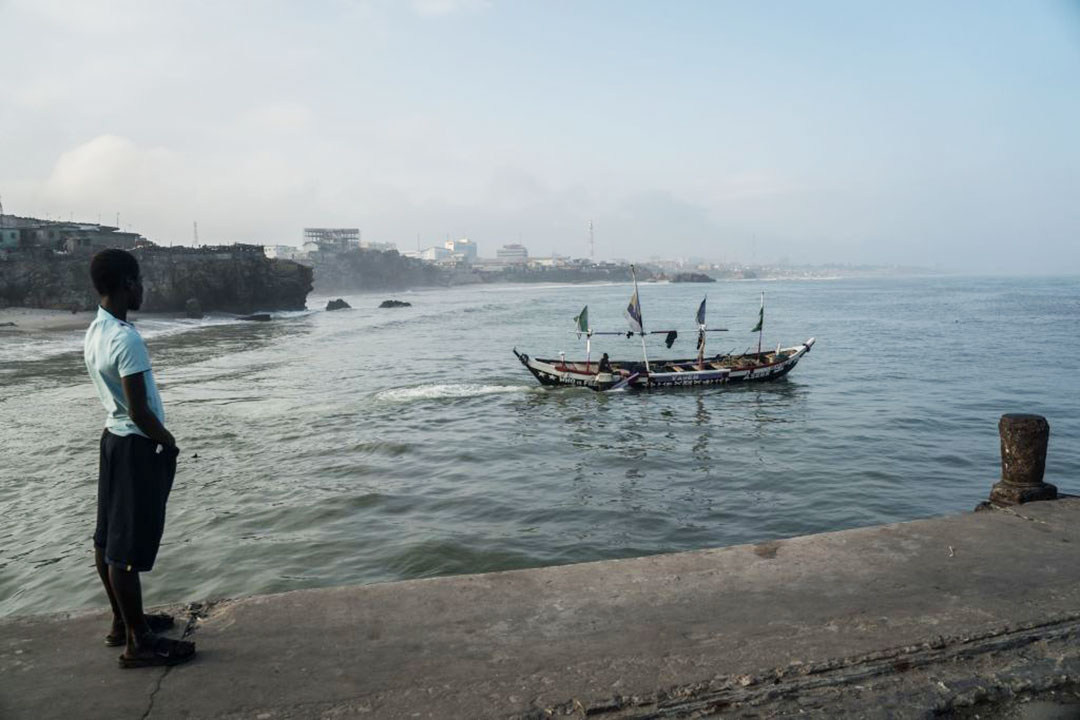‘Spyglass’ Makes Hidden Illegal Fishing Visible
ADF STAFF
More than 50 years ago, researchers announced a new international fishery in the Gulf of Guinea off the coast of West Africa.
“The protein‐hungry world has found a large and enormously rich fishing hole,” The New York Times proclaimed in 1964.
Today, the Gulf of Guinea is rife with illegal fishing operations. They compete with legitimate commercial vessels and local small-scale artisans working close to shore. They cross boundaries with impunity, use banned fishing gear, and wreck fragile undersea ecosystems by trawling the bottom. In the process, they are destroying the Gulf’s fish stocks and threatening the livelihoods of the local fishermen from Liberia to Gabon.
Although illegal fishing in the Gulf involves ships from all over the world, China has become a dominant force there at every level, from gigantic oceangoing factory ships that never make port to trawlers tearing up the seabed to small-scale artisanal fishermen.
“People tell me they suffer from the presence of Chinese vessels. They take everything,” Dyhia Belhabib, an Algerian expert in illegal fishing off West Africa, told ADF.
Devastating Impact
Working with Ecotrust Canada, where she is the principal investigator for fisheries, Belhabib recently launched Spyglass (spyglass.fish) to shine light on the often-opaque world of illegal fishing. Using a variety of public records, Spyglass reports the names, alleged violations and location of suspected illegal operations around the globe.
In the Gulf of Guinea, Spyglass has recorded nearly 200 illegal fishing incidents going back to 2000, including unauthorized fishing, use of illegal gear, fishing out of season, underdeclared catches, and destructive bycatch — sea creatures caught and thrown back, often dead or dying, and many of which local fishermen rely on for their livelihoods.
“Illegal fishing has a devastating impact on coastal fishing communities,” Steven Trent, executive director of the Environmental Justice Foundation, told ADF. “By destroying artisanal fishing gears, fishing destructively in in-shore areas, and even on some occasions attacking local fishers, illegal fishing vessels jeopardize the lives and livelihoods of coastal communities that have few alternative sources of food and income.”
In 2009 a group of British and Canadian biologists found that nearly 40% of the fish caught off West Africa were caught illegally — the highest rate in the world, according to a study published in the scientific journal PLoS One. A 2017 study published in Frontiers in Marine Science estimated that illegal fishing off the coast of West Africa costs nations collectively at least $2.3 billion a year.
In Ghana, for example, about 20% of the country’s labor force is tied to fishing. Although the number of ships working Ghanaian waters has declined, the size of the ships has increased. The national Fisheries Commission depends on ships to self-report their catches, a factor that can lead to underreporting, according to Norwegian fisheries researcher Stein Sundstøl Eriksen.
Throughout the Gulf, trawlers illegally chase fish in the near-shore zones reserved for artisanal fishers. Shallow near-shore waters also tend to be nursery areas for many fish species. By fishing indiscriminately in those waters — often with gear that produces high levels of unwanted bycatch — illegal fishing operations destroy local livelihoods and deplete juvenile fish stocks on a large scale, Trent said.
“Illegal fishing is essentially contributing to overfishing and pushing marine populations to the brink of collapse,” he said.
A Global Resource
Spyglass’ database holds records of 7,000 ships and 2,000 companies involved in illegal fishing around the world. Information comes from government agencies, news reports, eyewitnesses and other sources, Belhabib said..
Belhabib began the project while attending the University of British Columbia. Her spreadsheet of a few hundred names doubled in 2016 when the university brought West Africans to Vancouver to train them in researching illegal fishing. They added information from their countries to the database.
Belhabib continued to build her database after she left the university.
“When I reached 3,000 entries — vessels, companies, and different countries of the world — people in [fisheries] monitoring, control and surveillance agencies started asking me for information about various vessels, mainly from West Africa,” Belhabib said. “And I decided that it would be useful if it was in the public domain.”
When she moved to Ecotrust Canada, she brought her database with her, and Spyglass was born.
Ideally, Spyglass helps governments better understand who they are dealing with when boats or companies come seeking fishing permits, Belhabib said. Before Spyglass, records that were available often were in different languages and held by governments that provided differing levels of access, she said.
Because it depends on public records, Spyglass is far from exhaustive. Some countries show large numbers because they report more illegal fishing. Others take a hands-off approach or simply provide no data on illegal activity.
“The fact that there are not infractions noted in a country does not mean that county has no illegal fishing,” Belhabib said. “They’re just not catching it. And when they do catch it, they’re not reporting it.”


Comments are closed.